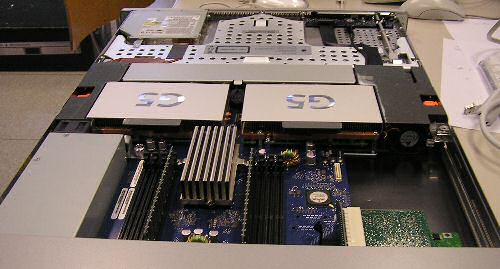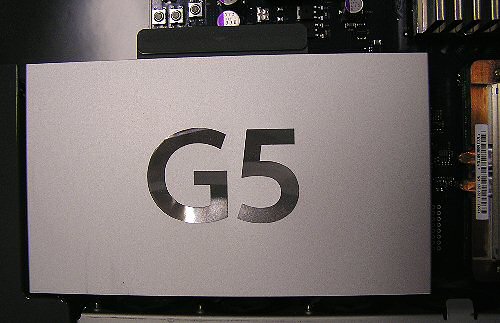Introduction
A little bit more than a month ago, AnandTech published "No more mysteries: Apple's G5 versus x86, Mac OS X versus Linux" with the ambitious goal of finding out how the Apple platform compares, performance-wise, to the x86 PC platform. The objective was to find out how much faster or slower the Apple machines were compared to their PC alternatives in a variety of server and workstation applications.Some of the results were very surprising and caught the attention of millions of AnandTech readers. We found out that the Apple platform was a winner when it came to workstation applications, but there were serious performance problems when you run server applications such as MySQL (Relational Database) or Apache (Webserver). The MySQL database running on Mac OS X and the Dual G5 was up to 10 times slower than on the Dual Opteron running Linux.

That is what we'll be doing in this article: we will shed more light on the whole Apple versus x86 PC, IBM G5 versus Intel CPU discussion by showing you what the G5 is capable of when running Linux. This gives us insight on the strength and weakness of Mac OS X, as we compare Linux and Mac OS X on the same machine.
The article won't answer all the questions that the first one had unintentionally created. As we told you in the previous article, Apple pointed out that Oracle and Sybase should fare better than MySQL on the Xserve platform. We will postpone the more in-depth database testing (including Oracle) to a later point in time, when we can test the new Apple Intel platform.
Why Bother?
Why do we bother, now that Apple has announced clearly that the next generation of the Apple machines will be based on Intel? Well, this makes our research even more interesting. As you will see further in the article, the G5 is not the reason why we saw terrible, slow performance. In fact, we found that the IBM PowerPC 970FX, a.k.a. "G5", has a few compelling advantages.As Apple moves to Intel, the only thing that makes Apple unique, and not yet another x86 PC OEM, is Mac OS X. That is why Apple will attempt to prevent you from running an x86 version of Mac OS X on anything else but their own hardware (using various protection schemes), as Anand reported in "Apple's Move to x86: More Questions Answered". Mac OS X will be the main reason why a consumer will choose an Apple machine instead of a Dell one. So, as we get to know the strengths and weaknesses about this complex but unique OS, we'll get insight into the kind of consumers who would own an Intel based machine with Mac OS X - besides the people who are in love with Apple's gorgeous cases of course....

Firstly, Apple's own website contradicts this in every tone. Secondly, we found a 2.5 GHz G5 to perform more or less like a Pentium 4 3 - 3.2 GHz in integer tasks. So, a 2 GHz G5 is probably around the speed of a 2.6 GHz Pentium 4. It is only natural that a much faster single CPU with a better disk and memory system outpaces a slower dual CPU in single threaded booting and development tasks. Thirdly, the whole CPU industry is focused now on convincing the consumers of how much better multi-core CPUs are compared to their "old" single core brethren.










47 Comments
View All Comments
JohanAnandtech - Friday, September 2, 2005 - link
Sorry couldn't resist :-). (for the rest of the world, pannekoek is dutch for Pancake)Desktop performance is ok, as desktop apps are similar to the workstation apps we tested in the first article. Those apps spend from 5-20% in the OS, while server apps spend up to 80% of their time in the OS!
However, I should point out that we tested Mac OS X SERVER, so it is a problem for the Xserves.
Pannenkoek - Friday, September 2, 2005 - link
I stand corrected then. However, my reasoning still applies, it's just that Apple relies even more on its brand than on technology to sell server systems apparently. Who runs Mac OS servers anyway, it's an oxymoron. ;-)P.S. Do not mock my nick, it served well in beating godlike UT bots, and should be honoured as much as Loque.
Tanclearas - Thursday, September 1, 2005 - link
"Apple told us that the problem lies in the Apachebench (the client side), which stalls from time to time and thus, generates too low of a load on the (Apache) server."How does this explanation make any sense? Linux obviously doesn't have a problem with these "stalls".
JohanAnandtech - Friday, September 2, 2005 - link
What follows is not what Apple said, but my interpretation...They are probably pointing out that the version for Mac OS X has a Mac OS X specific bug. Of course, who is to blame? I am sceptical like you.
mariush - Thursday, September 1, 2005 - link
Page 4 :We used the following on the Opteron based PCs:
Gcc -O2 -mcpu=G5 flops.c -o flops
And, on the G5 machines, we used:
Gcc -O2 -march=k8 flops.c -o flops
I think it's the other way around.
Houdani - Thursday, September 1, 2005 - link
Aye, was gonna point that out also.In addition, on page 3 should you list the Yellow Dog Linux along with OSX in the Software section for the Apple PowerMac G5?
Shinei - Thursday, September 1, 2005 - link
My question is, would the memory latencies be so high for the 970FX if high-end RAM was used for the Linux tests (like, say, some TCCD or BH-5 at 2-2-2-5), instead of the standard 3-3-3-8 SPD that ships with the G5 system? Or is there some limitation to the G5 motherboard that prevents posting with performance RAM as a way for Apple to ensure that only certain, accepted DIMMs are used with their computers?Anyway, these results are very telling about what the OSX86 Macs are going to perform like--that is to say, ~25% slower than the equivalent Windows/Linux boxes running the same hardware...
IntelUser2000 - Sunday, September 4, 2005 - link
That doesn't matter since they are testing workstations, Irwindale and Opteron is also using CAS3 RAM. No workstations/servers use 2-2-2-5 RAM.
The poor scores of OS X compared to Linux makes sense. G5 was rumored to be fast in speccpu benchmarks but came out to be slower. Must be that rumor systems were benched with Linux and the production was benched with OSX.
I am impressed with OS X's features though.
Jedi2155 - Thursday, September 1, 2005 - link
The G5 motherboard has the limitations due to Apple's way to insure you only buy certified ram. The SPD settings must be perfect.ceefka - Thursday, September 1, 2005 - link
I am humbled by the sheer expertise of Johan. Amazing work, Johan!This makes me even more curious about Intel's contribution to the next generation of Macs. How will they compare to the best G5s?